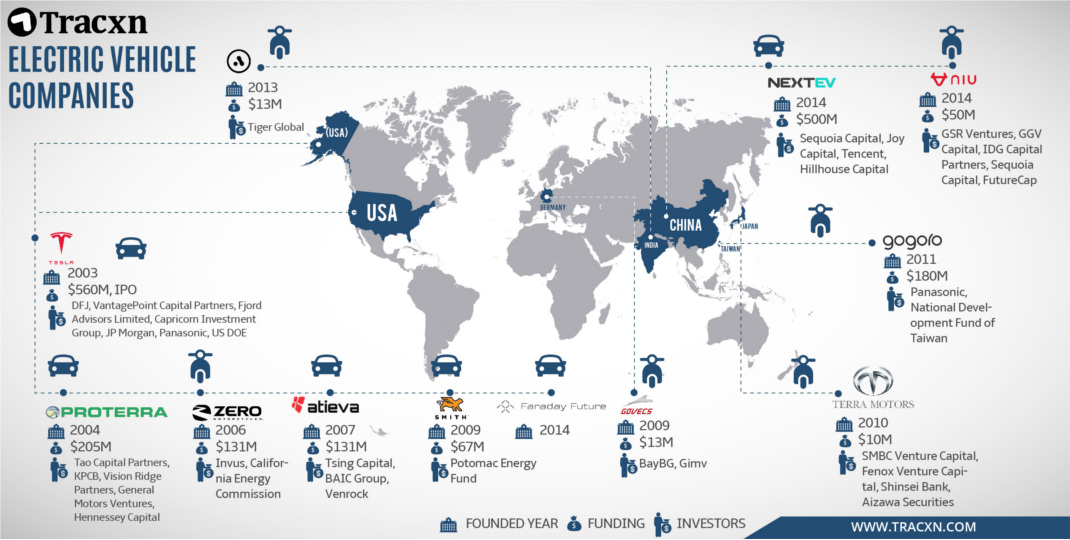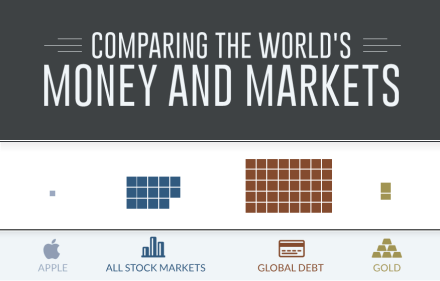Energy
Tesla’s Rise Has Inspired a Dozen New Electric Vehicle Rivals

Tesla’s Rise Has Inspired a Dozen New EV Rivals
If imitation is the sincerest form of flattery, then Elon Musk should be blushing.
In addition to the increased competition from big auto manufacturers, there are also now many venture-backed startups that are now kicking tires within the electric vehicle industry. According to Tracxn, a startup intelligence platform, some of Tesla’s rivals include Faraday Future, NextEV, and Atieva.
This set of companies has raised hundreds of millions from prominent venture capitalists in a bold effort to emulate the success of Tesla, which had its shares skyrocket from $17 to north of $200 since the company’s 2010 IPO.
Tesla’s Rivals
Faraday Future is possibly one of the more interesting names on this list. Backed by Chinese internet billionaire Jia Yueting, the company is notoriously secretive and hasn’t publicly revealed its CEO. It has however, hinted that its technology could potentially help mount a serious challenge to Tesla. Faraday Future executive Nick Sampson, the former head of vehicle and chassis engineering at Tesla, said that the company’s goal was to “revolutionize mobility the same way the iPhone revolutionized the phone industry”.
The company plans to build vehicles with a Variable Platform Architecture (VPA), which allows for vehicles to be built with multiple motors, along with powertrain configurations that can be customized for specific power, range and driving dynamics. Faraday Future recently broke ground on its $1 billion Nevada factory, aiming to launch its first vehicle for sale in 2017.
NextEV, another EV startup with Chinese connections, has reportedly raised more than $500 million from big names including Sequoia Capital, Tencent, and Joy Capital. Started by William Li, who previously founded the largest provider of car-pricing data to Chinese dealers, the company has a similar vision to that of Faraday Future: it plans to focus on connectivity and infotainment features to take the EV beyond just a form of transportation. To help guide in this plan, NextEV has hired Martin Leach, who previously served as the president of Ford Europe and also the CEO of Maserati.
Lastly, Atieva has made recent ground in the EV market after securing the majority-backing of one of China’s largest automakers. Founded in 2007 by Bernard Tse, who was also originally on Tesla’s Board of Directors, Atieva initially planned to provide monitoring software for electric vehicle battery packs. Today, the company has now reportedly moved towards manufacturing EVs with the vision of “redefining what a car can be by building an iconic new vehicle from the ground up”.
Building an electric car company from the ground up is a daunting task, and many imitators have already failed spectacularly. Fisker Automotive, for example, famously declared bankruptcy in 2013 even after burning through $1.4 billion in funding while losing $35,000 per car.
It’s possible this list may look way different in the near future.
Energy
Charted: 4 Reasons Why Lithium Could Be the Next Gold Rush
Visual Capitalist has partnered with EnergyX to show why drops in prices and growing demand may make now the right time to invest in lithium.

4 Reasons Why You Should Invest in Lithium
Lithium’s importance in powering EVs makes it a linchpin of the clean energy transition and one of the world’s most precious minerals.
In this graphic, Visual Capitalist partnered with EnergyX to explore why now may be the time to invest in lithium.
1. Lithium Prices Have Dropped
One of the most critical aspects of evaluating an investment is ensuring that the asset’s value is higher than its price would indicate. Lithium is integral to powering EVs, and, prices have fallen fast over the last year:
| Date | LiOH·H₂O* | Li₂CO₃** |
|---|---|---|
| Feb 2023 | $76 | $71 |
| March 2023 | $71 | $61 |
| Apr 2023 | $43 | $33 |
| May 2023 | $43 | $33 |
| June 2023 | $47 | $45 |
| July 2023 | $44 | $40 |
| Aug 2023 | $35 | $35 |
| Sept 2023 | $28 | $27 |
| Oct 2023 | $24 | $23 |
| Nov 2023 | $21 | $21 |
| Dec 2023 | $17 | $16 |
| Jan 2024 | $14 | $15 |
| Feb 2024 | $13 | $14 |
Note: Monthly spot prices were taken as close to the 14th of each month as possible.
*Lithium hydroxide monohydrate MB-LI-0033
**Lithium carbonate MB-LI-0029
2. Lithium-Ion Battery Prices Are Also Falling
The drop in lithium prices is just one reason to invest in the metal. Increasing economies of scale, coupled with low commodity prices, have caused the cost of lithium-ion batteries to drop significantly as well.
In fact, BNEF reports that between 2013 and 2023, the price of a Li-ion battery dropped by 82%.
| Year | Price per KWh |
|---|---|
| 2023 | $139 |
| 2022 | $161 |
| 2021 | $150 |
| 2020 | $160 |
| 2019 | $183 |
| 2018 | $211 |
| 2017 | $258 |
| 2016 | $345 |
| 2015 | $448 |
| 2014 | $692 |
| 2013 | $780 |

3. EV Adoption is Sustainable
One of the best reasons to invest in lithium is that EVs, one of the main drivers behind the demand for lithium, have reached a price point similar to that of traditional vehicle.
According to the Kelly Blue Book, Tesla’s average transaction price dropped by 25% between 2022 and 2023, bringing it in line with many other major manufacturers and showing that EVs are a realistic transport option from a consumer price perspective.
| Manufacturer | September 2022 | September 2023 |
|---|---|---|
| BMW | $69,000 | $72,000 |
| Ford | $54,000 | $56,000 |
| Volkswagon | $54,000 | $56,000 |
| General Motors | $52,000 | $53,000 |
| Tesla | $68,000 | $51,000 |
4. Electricity Demand in Transport is Growing
As EVs become an accessible transport option, there’s an investment opportunity in lithium. But possibly the best reason to invest in lithium is that the IEA reports global demand for the electricity in transport could grow dramatically by 2030:
| Transport Type | 2022 | 2025 | 2030 |
|---|---|---|---|
| Buses 🚌 | 23,000 GWh | 50,000 GWh | 130,000 GWh |
| Cars 🚙 | 65,000 GWh | 200,000 GWh | 570,000 GWh |
| Trucks 🛻 | 4,000 GWh | 15,000 GWh | 94,000 GWh |
| Vans 🚐 | 6,000 GWh | 16,000 GWh | 72,000 GWh |
The Lithium Investment Opportunity
Lithium presents a potentially classic investment opportunity. Lithium and battery prices have dropped significantly, and recently, EVs have reached a price point similar to other vehicles. By 2030, the demand for clean energy, especially in transport, will grow dramatically.
With prices dropping and demand skyrocketing, now is the time to invest in lithium.
EnergyX is poised to exploit lithium demand with cutting-edge lithium extraction technology capable of extracting 300% more lithium than current processes.

-

 Lithium1 day ago
Lithium1 day agoRanked: The Top 10 EV Battery Manufacturers in 2023
Asia dominates this ranking of the world’s largest EV battery manufacturers in 2023.
-

 Energy6 days ago
Energy6 days agoThe World’s Biggest Nuclear Energy Producers
China has grown its nuclear capacity over the last decade, now ranking second on the list of top nuclear energy producers.
-

 Energy4 weeks ago
Energy4 weeks agoThe World’s Biggest Oil Producers in 2023
Just three countries accounted for 40% of global oil production last year.
-

 Energy1 month ago
Energy1 month agoHow Much Does the U.S. Depend on Russian Uranium?
Currently, Russia is the largest foreign supplier of nuclear power fuel to the U.S.
-

 Uranium2 months ago
Uranium2 months agoCharted: Global Uranium Reserves, by Country
We visualize the distribution of the world’s uranium reserves by country, with 3 countries accounting for more than half of total reserves.
-

 Energy2 months ago
Energy2 months agoVisualizing the Rise of the U.S. as Top Crude Oil Producer
Over the last decade, the United States has established itself as the world’s top producer of crude oil, surpassing Saudi Arabia and Russia.
-

 Green1 week ago
Green1 week agoRanked: The Countries With the Most Air Pollution in 2023
-

 Misc2 weeks ago
Misc2 weeks agoAlmost Every EV Stock is Down After Q1 2024
-

 AI2 weeks ago
AI2 weeks agoThe Stock Performance of U.S. Chipmakers So Far in 2024
-

 Markets2 weeks ago
Markets2 weeks agoCharted: Big Four Market Share by S&P 500 Audits
-

 Real Estate2 weeks ago
Real Estate2 weeks agoRanked: The Most Valuable Housing Markets in America
-

 Money2 weeks ago
Money2 weeks agoWhich States Have the Highest Minimum Wage in America?
-

 AI2 weeks ago
AI2 weeks agoRanked: Semiconductor Companies by Industry Revenue Share
-

 Travel2 weeks ago
Travel2 weeks agoRanked: The World’s Top Flight Routes, by Revenue












